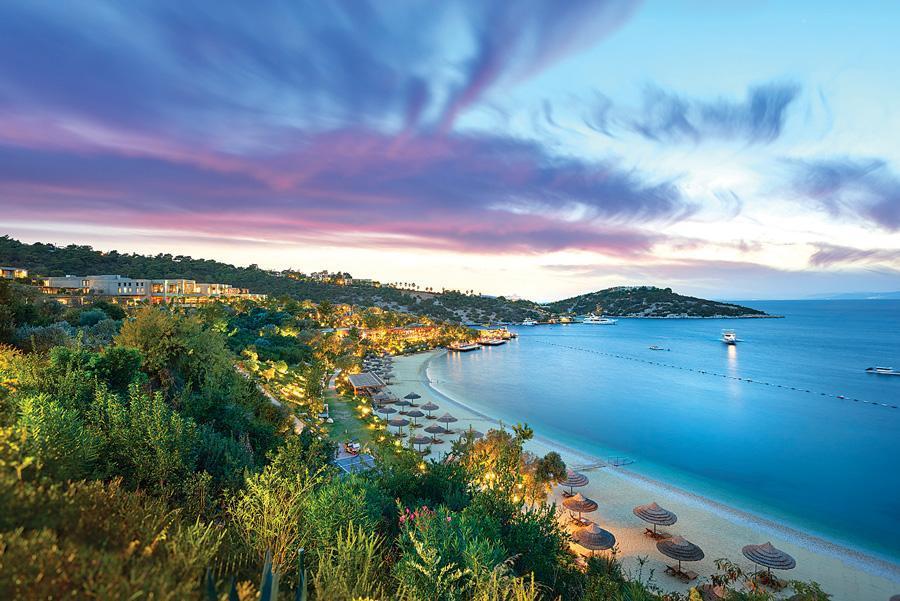
When it comes to summer vacation in Turkey, it is one of the first places to come to mind. It has been discussed to death. It has been discovered countless times. Each summer, it has added new beautiful sites to its bulging portfolio. It has satisfied backpacking wanderers as well as those who tiptoe at the heights of opulence. Even if it feels drained at times, it has always managed to stand upright.
The idiom “Bodrum every night” wasn’t spoken in vain. With its fast nights, deserted trails, tiny natural beaches and interesting delicacies, it has managed to stay on as a center of attraction for every segment. Now, in your presence: Bodrum.
Bodrum, which was described by the Fisherman of Halicarnassus with the words, “Don’t think that you will go as you came; the ones before you were the same; they all went off after leaving their minds in Bodrum,” has a deeply-rooted history dating back thousands of years. According to Herodotus, a native of Bodrum, the city was established in the 1,000s A.D. by the Dorians. Byzantine and Turkish principalities later dominated the area known as Halicarnassus in ancient times. In the era of Suleiman the Magnificent, it was incorporated into Ottoman lands. I begin my quest to discover the region’s historic heritage at Bodrum Castle.
After wandering through the castle and along the seaside lined by blue cruise yachts, I move on to the bazaar. It’s hard to leave the counters empty-handed after browsing through heaps of Bodrum T-shirts, leather sandals, handmade glassware, authentic jewelry, sponges, giant seashells and coral. My destination - which I will reach with the accompaniment of the gentle Aegean breezes that blow off a year of weariness from my body - is the coves of Bodrum. The coves, nearly all of which are Blue Flag certified, are famous for their beaches and dockside parties.
There are many options for shopping and dining in Torba, which possesses an impressive variety of holiday villages. Gümbet, east of Ağaçlı Cove, is full of hotels, boardinghouses and holiday villages.
Tiny natural beaches are hidden in the cove, which is a popular stopover for tour yachts coming from Bodrum. The next-door neighbor of Gümbet, Akvaryum (Aquarium) Cove, is an indispensable stop for daily tour yachts. The shores of Turgutreis, which are dotted with tangerine trees, are perfect for watersports. Yalıkavak, famed for its old-fashioned windmills, greets visitors from land and sea with its chic restaurants. The Yalıkavak Marina nearby, which was built with an eye for detail, offers the highest level of comfort for yachts. The beach clubs in the area turn seaside sun and fun into a sort of open air party with carefully-selected music and various offerings of food and drink. Life on the coves is just about the same every day.
A day in Bodrum starts with a long breakfast, continues with naps and relaxation at noon and simmers down with sunshine and bathing in the evenings. With the arrival of dusk, after all the weariness of the day is washed off; it is time to flow in to the restaurants and entertainment venues.
If spending time on the beaches of Bodrum is not enough, there are three alternatives, which will plunge you into the cold waters of the Aegean: diving schools, sailing schools and the blue cruise, which has become permanently associated with Bodrum. Bitez, renowned for its night clubs and beaches of fine sand, is the surf and sailing center of Bodrum with its breezy, shallow seas.
There are many places to go diving in Bodrum, which promises an unforgettable experience to divers with its underwater flora and mysterious shipwrecks.
[HH] Little-known coves
Karakaya, standing high between Sandima and Gümüşlük in the vicinity of Yalıkavak, seems to present a view of Bodrum as it appeared a hundred years ago. Baryglia, the ancient town near Güllük, is full of ruins from the Byzantine period. The best place to stop for a delicious snack is Kuyucak Harbor, which has been used as a natural harbor since antiquity. If you’d like to meet the fulfilled, cheerful inhabitants of a modest Bodrum town, you’ll have to mosey on over to Gümüşlük.
There are many options for those who would prefer to have dinner at one of the restaurants on the beach instead of on the yacht. You will have the chance, if you wish, to see the shipwrecks at the bottom of the sea in the lustrous waters of this sterling village, more than 2,000 years since the ancient town of Myndos was drowned.
Though Gümüşlük doesn’t offer many flashy touristic activities, one can go for a swim, walk to Tavşan (Rabbit) Island and watch a breathtaking sunset. Mazıköy is also among Bodrum’s little-known, hidden treasures. This virginal Aegean village, which can be reached by following the road to Mumcular after taking a left at Güvercinlik once you have passed Güllük, is an earthly paradise with its crystal clear sea, stately trees and rocks.
The Mazı beach doesn’t lose its pleasant breeze even on the hottest days of the year. The pleasure of swimming in the shade of oleander trees alongside shining, spotless beaches is unbelievable. The long stretches of beach and rocks are suitable for sunbathing and fishing. It’s up to you to explore the nearby coves by renting a yacht from the pier on the beach. Stopping by the historical ruins of Kisebükü is considered a tradition nowadays. The cove, which is home to a bath, cistern and church ruins, is also an essential of blue cruises. The hand-woven rugs and carpets sold at the village square are one of Mazı’s surprises. In summary, there is something for everybody in Bodrum. Which Bodrum is yours?